It is most likely to have seen an increased number of people especially since writing to ask Alexa, Siri, or Google assistant, has been replaced with asking out loud. Whether it is the question of What is the weather like? or Order more dog food, a voice command is becoming a way of life. The insinuation of that change is reshaping the manner through which online shoppers find, assess and purchase products.
Behavior of voice based ecommerce behavior is still increasing at an accelerated pace. This research reveals that more than half of all households around the world possessed voice activated devices by 2024 and voice commerce is already crossing into billions in spending per year.¹ Miss this change and a company can end up being left behind to a significant opportunity.
In this post, we will look at how voice search is also transforming the ecommerce funnel—the awareness, the discovery, and the repeat customers—and how you can keep up with the changes.
1. Understanding the Ecommerce Funnel in 2025
Traditionally, the ecommerce funnel has four main stages:
- Awareness – customer gets to be aware of your brand or product
- Consideration – they compare and assess features
- Decision – they buy something
- Retention – they come back and make a purchase once again
By 2025, there is a more dynamic funnel than ever before. The recommendation that AI offers, voice assistants, chatbots, and utilization of mobile technology helps to confuse boundaries between phases. A customer could find out about a product via Alexa, go to his phone to find out more about it, and buy it hands free all without making even a single stop in the site.
The linearity is dissolved by voice interaction. What we are now faced with are micro moments, brief voice searches that can have an effect on any funnel step almost immediately.
2. The Rise of Voice Search: Key Trends
More Voice Enabled Devices
Voice assistants on phones and smart speakers have become domestic commodities. Lots of people can use Alexa or Google assistant or Siri in the kitchen, in the car, at work, or even in a meeting room, and voice search has become more natural and much more effortless.
Shift Toward Conversational Queries
Customers are no longer searching in a browser window for the words best earbuds 2025 – they are speaking, literally, Hey Google what are the best wireless earbuds under 3000 rupees? The content has its linguistic nature: speech is conjectural and is generally expressed as complete unitary sentence, a factor that also influences how businesses optimize speech.
Younger Generations Embrace It
Generation Z and Millennials are in particular very comfortable using voice search. They want anything fast and easy and voice search will provide this. The younger shoppers are kept interested in brands that provide friction free voice buying experiences.
3. Where Voice Search Impacts the Funnel Most
Top of the Funnel (Awareness)
Voice search is potent on the discovery level. What people wonder is:
- Alexa, which is the most economical phone currently?
- Hi Siri, what are the benefits of the cordless vacuum cleaners?
These are the initial questions that determine brand familiarity. When the product contents on your page are adapted to such conversational search queries, then it becomes likely that you will appear in the results of such voice searches, providing customers with an opportunity to know about your brand even before they visit the site.
Middle of the Funnel (Consideration)
The voice search is incredibly massive when comparing products as well:
- Google, whose cell phone has a longer battery, phone A or phone B?
- Hey Google, show me the reviews of a new treadmill.
The local intent is also relevant in this case:
- Alexa, show me the best running shoes around my area.
By appearing highly in these voice queries, you can play a critical role in the decision making process even before the person has take the trouble of entering some keyword.
Bottom of the Funnel (Decision)
At this phase, actual purchase can also be accelerated by voice search:
- Alexa, order coffee beans.
- Hey Google, purchase more dog food.
The use of smart devices can be linked to payment data so that checkout can be pure without any obstacles between desire and buy. The voice activated shopping is particularly convenient when making repeat purchases or replenishing purchases.
4. Optimizing for Voice Search in Ecommerce
To tap into voice search effectively, this checklist helps:
- Long tail keywords should be used conversational
Write in the language that apes colloquial language. In other words, try to think not of the best shoes to walk but of what the best walking shoes are in terms of back pain. - Target position zero snippets
Position your FAQs, product pages and posts on blogs to be among those listed in snippet boxes. These are often read by voice assistants. - Strengthen your local SEO
Make sure your company Name, Address, and Telephone (NAP) information is alike pretty much everywhere—Google Businesses, surveys, and records. Store near me queries running off voice are the result of the same. - Mobile friendliness and speed
The mobile devices are characteristically voice users clicking through. Conversions require a fast loading and responsive site.
5. Case Studies and Examples
Retailer Using Alexa Skills
There is a 20-30 percent increase in repeat purchases in the major retailers who provide voice shopping through Alexa where customer can add to cart, reorder what they frequently used to purchase, and track delivery: Staples, such as groceries and pet food, are items that the customers love to order repeatedly using their voices.
Brand Optimizing Q&A Format
Another ecommerce business received 50% more migrations to that same brand coming from voice following an content rework to conversational FAQs — things like “How do I clean my yoga mat?” or “What size treadmill will fit in my living room?” These phrases link for to a search users query and are the ones that feed to featured snippets.
6. Challenges and Limitations
Voice commerce brings many advantages, but there are hurdles:
- Lack of voice behavior analytics
Voice is tricky to track: it is not always possible to click or see a session associated with the voice purchase. This complicates the ROI measurement. - Issue of privacy
Others are concerned that voice devices are listening; therefore, it is imperative to rely on and be transparent in data use. - Products that are visual sold through audio are not easy to sell
Most products are based on fashion, gadgets, furniture—all of which are dependent on visual seduction. Image descriptions and demos cannot just be substituted with voice descriptions.
7. The Future of Voice Commerce
What’s next in voice shopping?
- Deeper device integration
More smartphones, TVs, smart home devices, and cars will also have full voice control ecommerce technological capability. Voice may be used as the interface interface to most everyday purchases. - AI personalization
The AI voice assistants will be able to ascertain personal taste and the history of behavior and make potentially relevant suggestions (“Siri, get my usual coffee”). - Voice controlled AR shopping
It would be like using your phone’s camera to look at a product, saying “show me in green,” and it shows up in augmented reality. Voice is used as a user interface for AR graphics.
Multimodal journeys—where users switch between voice, mobile, and voice devices—will drive the next level of shopping UX.
Conclusion
Voice search is not a novelty tool, as it is transforming all the processes of the product finding and purchasing online:
- Awareness: Voice search is relevant where brand awareness and initial research are concerned.
- Consideration: Conversation queries can assist the users to compare and filter products.
- Ruling: Voice Command buying instructions will ease even the checking out.
Seeing that more consumers are shopping using voice, one may easily miss out on voice search optimization if he is yet to do it. It is time to make voice SEO, feature snippet optimization, and conversational content a part of the equation.
FAQs
Voice search forces ecommerce sites to lose ecommerce sites’ traditional long tail, descriptive keywords in favor of conversational, FAQ style content that mirrors what people say and often snag the feature snippet.
Yes. Once connected to a mode of payment, such as devices like Alexa, Google Assistant and Siri, a user can reorder or purchase directly through speech.
Both are becoming more popular in voice search. Smart speakers have conquered most of the household time, with smart phones being on-the-go voice queries.
Most frequently, the purchases of household essentials such as pet food, groceries, and repeat use product are ordered through voice assistants.
The first step should be to optimize the content into conversational FAQ, make sure your local SEO is high, and aim at featured snippets, also don spotted make your site fast and mobile-friendly.



